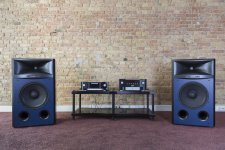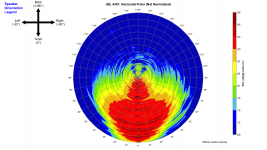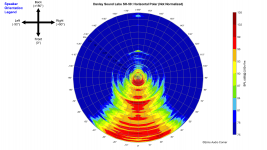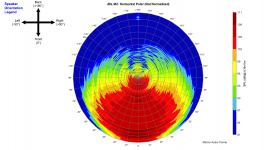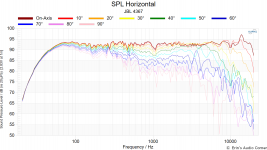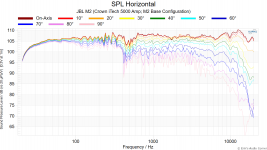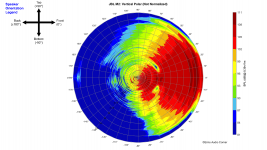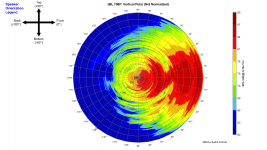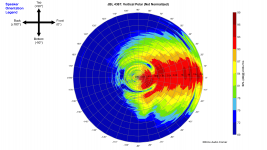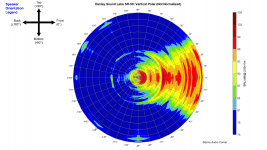A few years back I heard the JBL 4367 back-to-back with a bunch of great Revel speakers. I liked the 4367 a lot.

The JBL waveguide is very asymmetric; much more so than the JBL M2. Both speakers use very similar components, IIRC the tweeter is identical. (JBL D2430K)

The JBL waveguide is very asymmetric; much more so than the JBL M2. Both speakers use very similar components, IIRC the tweeter is identical. (JBL D2430K)
Attachments
In this week's episode of "Erin's Audio Corner", Erin was raving about the 4367.
This caught me a bit by surprise. I've never heard the M2, but from what people had told me, the JBL M2, 4367, 708P etc all have a similar sonic "signature." Basically the idea is that what you're mostly getting for the extra money is higher power handling and better dynamics.
If you were blindfolded, the 4367 shouldn't sound a heck of a lot different than the M2, or at least that's the theory.
This caught me a bit by surprise. I've never heard the M2, but from what people had told me, the JBL M2, 4367, 708P etc all have a similar sonic "signature." Basically the idea is that what you're mostly getting for the extra money is higher power handling and better dynamics.
If you were blindfolded, the 4367 shouldn't sound a heck of a lot different than the M2, or at least that's the theory.
Erin speculated that the excellent sound of the 4367 may be due to the fact that the treble narrows at high frequency.
I've never heard the M2, so I can't speak to that. But I know the M2 and the 4367 both use the same compression driver... so both should narrow at high frequency.
Attached are Erin's nifty "globe plots" of the JBL M2 and the JBL 4367, on the horizontal axis.
I've also included the Danley SH50; I'll explain why in a sec.

JBL M2 horizontal "globe plot"

JBL 4367 horizontal "globe plot"

Danley SH50 horizontal "globe plot"
I've never heard the M2, so I can't speak to that. But I know the M2 and the 4367 both use the same compression driver... so both should narrow at high frequency.
Attached are Erin's nifty "globe plots" of the JBL M2 and the JBL 4367, on the horizontal axis.
I've also included the Danley SH50; I'll explain why in a sec.

JBL M2 horizontal "globe plot"

JBL 4367 horizontal "globe plot"

Danley SH50 horizontal "globe plot"
Attachments
On the horizontal axis, you can definitely see that the beamwidth of the M2 is indeed wider above 10khz.
So it uses the same compression driver, but manages to achieve wider beamwidth, even with a 1.4" throat. (9643Hz is 1.4" wide.)
Geddes has hinted that there's ways of widening the beamwidth of a waveguide, even the frequencies that are shorter than the throat of the compression driver. So there's some magic going on here. A few hours of crunching numbers in ATH might answer this. I wonder if the weird 'knuckles' on the M2 contribute?
So it uses the same compression driver, but manages to achieve wider beamwidth, even with a 1.4" throat. (9643Hz is 1.4" wide.)
Geddes has hinted that there's ways of widening the beamwidth of a waveguide, even the frequencies that are shorter than the throat of the compression driver. So there's some magic going on here. A few hours of crunching numbers in ATH might answer this. I wonder if the weird 'knuckles' on the M2 contribute?
Attachments
I can only speculate on why Erin liked the sound of the 4367 so much. When I heard it, I liked it a lot. Possibly in my top five or top ten of speakers.
My hunch is that vertical directivity might be the key here.
Whoever made the 4367 is a bit of a wizard, because they did a really great job of narrowing the vertical directivity across nearly the entire bandwidth of the speaker.
Obviously, we can do that with a waveguide. And JBL did. But pushing the beamwidth control all the way down to about 300Hz is impressive, when you consider that the 4367 waveguide is about ten inches tall, and it's beamwidth control should be collapsing around 1350Hz. Based on a lot of the stuff I've done experimentally, using Vituixcad in particular, I'll bet JBL juggled the following:
Vertical spacing of the woofer and tweeter, crossover slope of the drivers, depth of the waveguide, cabinet dimensions, etc.
In particular, the cabinet is 36" tall. 375Hz is 36" long. So I think a lot of the "magic" here is that the use of fairly large spacing, and a really huge midrange, allows them to control the directivity to a lower frequency. In some respects the JBL 708P is like a 1/16th scale version of the 4367. But due to it's much much smaller size, it's vertical beamwidth is wider, and the 708P loses pattern control more than an octave higher in frequency.
YMMV, but something that I noticed with the Gedlee Summas and with the Danley SH50 is that getting directivity control below 1khz goes a looooong way towards "getting the room out of the picture."
From a subjective perspective, it's a catch 22 in a lot of ways. If you have a speaker with narrow directivity, it has really pinpoint imaging. And if you can get that beamwidth control down to 500Hz or 700Hz, it's an unmistakable improvement over small speakers. (And the extra dynamics are a bonus.) But I find that it's ALSO nice to have some high frequency reflections off of the sidewalls, to add some "air" to the presentation. Perhaps this is why two way speakers with 7" woofers and 1" tweeters are such a staple; the beamwidth narrows in the upper midrange, reducing harmful reflections off the sidewalls, but the beamwidth is very wide above the xover point, because the wavelengths are larger than the tweeter.
Here's the data, courtesy of erinsaudiocorner:

This is the vertical "globe map" of the JBL 4367. Note how the beamwidth is narrow, and maintains that pattern down low.

Danley SH50 is even narrower, and it's pattern is symmetrical on horizontal and vertical. (All the other speakers in this discussion are narrow vertically and wide horizontally, except for the JBL M2 which is wide on BOTH axes.)

Here's the JBL M2. Note that even though it's compression driver is identical, it's vertical beamwidth is significantly wider.

JBL 708P falls between the M2 and the 4367. But it throws a lot of radiation at the floor and ceiling in the range of 280Hz - 1khz because the woofer, cabinet and waveguide are smaller. Even with identical drivers, I think you may be able to improve on the 708P by using a larger cabinet and tweaking the spacing and crossover.
My hunch is that vertical directivity might be the key here.
Whoever made the 4367 is a bit of a wizard, because they did a really great job of narrowing the vertical directivity across nearly the entire bandwidth of the speaker.
Obviously, we can do that with a waveguide. And JBL did. But pushing the beamwidth control all the way down to about 300Hz is impressive, when you consider that the 4367 waveguide is about ten inches tall, and it's beamwidth control should be collapsing around 1350Hz. Based on a lot of the stuff I've done experimentally, using Vituixcad in particular, I'll bet JBL juggled the following:
Vertical spacing of the woofer and tweeter, crossover slope of the drivers, depth of the waveguide, cabinet dimensions, etc.
In particular, the cabinet is 36" tall. 375Hz is 36" long. So I think a lot of the "magic" here is that the use of fairly large spacing, and a really huge midrange, allows them to control the directivity to a lower frequency. In some respects the JBL 708P is like a 1/16th scale version of the 4367. But due to it's much much smaller size, it's vertical beamwidth is wider, and the 708P loses pattern control more than an octave higher in frequency.
YMMV, but something that I noticed with the Gedlee Summas and with the Danley SH50 is that getting directivity control below 1khz goes a looooong way towards "getting the room out of the picture."
From a subjective perspective, it's a catch 22 in a lot of ways. If you have a speaker with narrow directivity, it has really pinpoint imaging. And if you can get that beamwidth control down to 500Hz or 700Hz, it's an unmistakable improvement over small speakers. (And the extra dynamics are a bonus.) But I find that it's ALSO nice to have some high frequency reflections off of the sidewalls, to add some "air" to the presentation. Perhaps this is why two way speakers with 7" woofers and 1" tweeters are such a staple; the beamwidth narrows in the upper midrange, reducing harmful reflections off the sidewalls, but the beamwidth is very wide above the xover point, because the wavelengths are larger than the tweeter.
Here's the data, courtesy of erinsaudiocorner:

This is the vertical "globe map" of the JBL 4367. Note how the beamwidth is narrow, and maintains that pattern down low.

Danley SH50 is even narrower, and it's pattern is symmetrical on horizontal and vertical. (All the other speakers in this discussion are narrow vertically and wide horizontally, except for the JBL M2 which is wide on BOTH axes.)

Here's the JBL M2. Note that even though it's compression driver is identical, it's vertical beamwidth is significantly wider.

JBL 708P falls between the M2 and the 4367. But it throws a lot of radiation at the floor and ceiling in the range of 280Hz - 1khz because the woofer, cabinet and waveguide are smaller. Even with identical drivers, I think you may be able to improve on the 708P by using a larger cabinet and tweaking the spacing and crossover.
Attachments
Last edited:
I can't find the stands right now, but I vaguely recall that JBL used to sell some for the 4367. It tilted the speaker back a bit.
If you look at how low the tweeter is, and how narrow the beamwidth is, those stands are probably a good idea.
They looked like the pic attached.
If you look at how low the tweeter is, and how narrow the beamwidth is, those stands are probably a good idea.
They looked like the pic attached.
Attachments
I can only speculate on why Erin liked the sound of the 4367 so much.
I think I discussed it in the video but if we are comparing directly to the M2 the one thing I noted about the M2 (in the 'stock' configuration) was that the treble was too much. If you look at the estimated in-room response(s) of the two, you can see what I mean.
So, there are two things:
1) The 4367 EIR response trends downward >6kHz. The M2 is flat (until about 15kHz or so).
2) The 4367 has a slightly increasing DI while the M2 has a flat DI.
The combination of #1 & #2 are - based on my experience thus far - the reason why I would likely prefer the 4367, at least wrt mid/high frequency, over the M2. I've said this a number of times elsewhere but it continues to hold true: a constant DI with a flat (or even boosted) on-axis response yields a boosted HF in the EIR which always comes off as "bright" to me.
It's also worth noting that the M2 has a shelf in the midbass/midrange transition where the mid/highs are about 1dB above the bass region.
I'd love to have the ability to ABX the two but that will likely never happen. Based on my experience, I think I'd have to choose the 4367 if I were buying for myself. My buddy who demoed both and purchased the M2 thinks the 4367 sounded horrible. So, there you have... two perfectly different opinions. Of course, speakers aren't chosen based solely on one bandpass region over another. There are multiple factors. One pro for the M2 is simply that it's physically larger and doesn't need a weird stand to get the tweeter (or the line just below that) at ear-height, such as the 4367 does.
FWIW, I don’t believe the waveguides are the same. I’m almost certain they are not but can’t verify at the moment.
All of that said, good lord, are the 4367's expensive. The fellow who loaned them to me picked them up used for about half-price. I told him if he ever decides to sell them to please let me know first and I'd drive to Chicago to pick them up. 🙂
Last edited:
I think you might be being fooled by the 0 to 3dB area on the normalized plot and how even it is. When you look at the DI and the vertical line charts it is clear that vertical directivity is being lost quickly from 2K to 1K and below where it is being blended with the woofer.Whoever made the 4367 is a bit of a wizard, because they did a really great job of narrowing the vertical directivity across nearly the entire bandwidth of the speaker.
Obviously, we can do that with a waveguide. And JBL did. But pushing the beamwidth control all the way down to about 300Hz is impressive, when you consider that the 4367 waveguide is about ten inches tall, and it's beamwidth control should be collapsing around 1350Hz. Based on a lot of the stuff I've done experimentally, using Vituixcad in particular, I'll bet JBL juggled the following:
Hi Patrick,I think you might be being fooled by the 0 to 3dB area on the normalized plot and how even it is. When you look at the DI and the vertical line charts it is clear that vertical directivity is being lost quickly from 2K to 1K and below where it is being blended with the woofer.
Greg Timbers designed the 4367. It was his last design before leaving JBL.
One thing l would add is that most domestic living rooms have a longer reverberation time (RTA60 measurement) than an recording control room.
What you actually hear is the total energy off all the relevant surfaces of the T 0db - -60 db time envelope. A short reverberation time in the is going to sound less intense than a longer reverberation time. The curves don’t tell you that.
So you are right in that an asymmetrical wave guide can control the total sound energy at particular frequencies of interest.
The tweeter used to cost around $1600 a pair in 2017, it's down to $720 a pair now.
There's no listed price for the waveguide, but they're available. I'd guess about $300 a pair.
The woofer is the easy part, plenty of candidates for about $600 a pair.
Cabinet will be about $300 a pair.
The trick will be finding the crossover schematic.
Should be possible to clone them for about 15% of the retail price.
There's no listed price for the waveguide, but they're available. I'd guess about $300 a pair.
The woofer is the easy part, plenty of candidates for about $600 a pair.
Cabinet will be about $300 a pair.
The trick will be finding the crossover schematic.
Should be possible to clone them for about 15% of the retail price.
http://www.audioheritage.org/vbulle...7c95ad0c0c1e89&p=384175&viewfull=1#post384175The trick will be finding the crossover schematic.
https://www.audiosciencereview.com/forum/index.php?threads/jbl-4367-inside-photos-video.2293/
There is a white paper that explains the charge coupled crossover a little too
https://www.jblsynthesis.com/on/dem...f5318/pdfs/JBL Synthesis 4367 White Paper.pdf
https://www.jblsynthesis.com/on/dem...f5318/pdfs/JBL Synthesis 4367 White Paper.pdf
JBL seems to put all mess at the head shadow range. 1-2khz are so long they need to wrap around the head and neck.vertical directivity is being lost quickly from 2K to 1K and below where it is being blended with the woofer.
Let's see:
2 x JBL D2430K - $1200 - https://reconingspeakers.com/products-page/jbl-d2430k-tweeter-jbl-446213-001x-for-vtx/
(The price I posted earlier, which was about 45% cheaper, was the 2430H)
2 x JBL 2216ND-1 - $800? - https://reconingspeakers.com/products-page/jbl-2216nd-1-woofer-for-4367-320-0045-002/ out of stock and price is a guess
2 x crossover - $200?
2 x cabinet - $300?
MSRP = $16K
Total = $2700 or about 16.9% as much
Of course a real will have much better resale value...
2 x JBL D2430K - $1200 - https://reconingspeakers.com/products-page/jbl-d2430k-tweeter-jbl-446213-001x-for-vtx/
(The price I posted earlier, which was about 45% cheaper, was the 2430H)
2 x JBL 2216ND-1 - $800? - https://reconingspeakers.com/products-page/jbl-2216nd-1-woofer-for-4367-320-0045-002/ out of stock and price is a guess
2 x crossover - $200?
2 x cabinet - $300?
MSRP = $16K
Total = $2700 or about 16.9% as much
Of course a real will have much better resale value...
I think this is true. However, due to the narrowing pattern shape that JBL decided upon with this waveguide, the pattern loss is hidden in its overall angled shape. There is no secret to be discovered in this, it is obvious that there primary concern was a regression from bass to highs in PIR. Due to the audience at this price level, it is of minor concern that the full frequency spectrum is only available at a small area listening position. It’s a proprietary gesture.I think you might be being fooled by the 0 to 3dB area on the normalized plot and how even it is. When you look at the DI and the vertical line charts it is clear that vertical directivity is being lost quickly from 2K to 1K and below where it is being blended with the woofer.
also lol.Lol 🙂
My speakers have a similar design subjectively room interaction is reduced. Their price is a fraction of the JBL (even the parts) if you want to build a pair. They also avoid the response narrowing at the crossover as the JBL as they have a much lower horn crossover frequency.
2 x crossover - $200?
Honestly, if I were going to DIY this same speaker, I'd go active. I'm not saying it's entirely necessary. But if you can afford the extra channels of amplification (which really don't need to be high powered given the sensitivity) then you can do some really good work (lower crossover point with steeper slopes, minor EQ adjustment, season to taste, etc) with a miniDSP ... or if you want to get super fancy, the DEQX. 😀
Honestly, you've kind of given me some motivation here... might be a worthwhile project video in the future (when/if I ever get the free time!).
2 x JBL 2216ND-1
Hmph. Someone told me the same driver was used between the 4367 and the M2. I didn't verify. But what I do see in your link is that the M2 woofer is a different model number (and is also backordered, BTW).
I wonder if this means the two woofers are truly different. There was a resonance from the M2 woofer itself (when measured free-air) that showed up in the in-speaker measurements. A viewer pointed out they didn't see that same resonance in the 4367. He was perplexed why that would be the case. But maybe the woofers are indeed different.
Hmph. Someone told me the same driver was used between the 4367 and the M2. I didn't verify. But what I do see in your link is that the M2 woofer is a different model number (and is also backordered, BTW).
I wonder if this means the two woofers are truly different. There was a resonance from the M2 woofer itself (when measured free-air) that showed up in the in-speaker measurements. A viewer pointed out they didn't see that same resonance in the 4367. He was perplexed why that would be the case. But maybe the woofers are indeed different.
The -1 has aguaplas on the outer rim backside of the cone and a lower FS than the generic 2216. Probably has a softer suspension as well it's only about 11 grams of added mass. If you look at the curves it also looks like the aguaplas also helps smooth the response as you noted.
I built a passive version of the M2 and went for maximally flat on axis response. Slight step at the crossover. You are spot on they put out quite a bit of HF into the room and I have to run them with -1dB on the waveguide or else it's a bit much.
Rob 🙂
http://www.audioheritage.org/vbulle...9-2216Nd-1-Measurements&highlight=2216+2216-1
- Home
- Loudspeakers
- Multi-Way
- Highly Asymmetrical Waveguides
